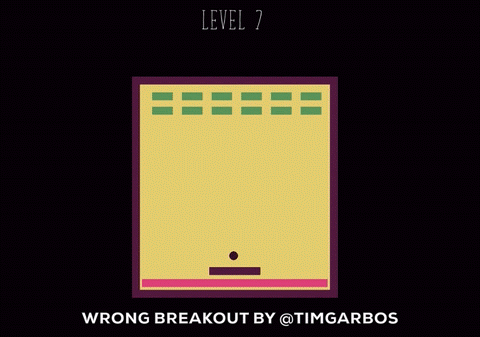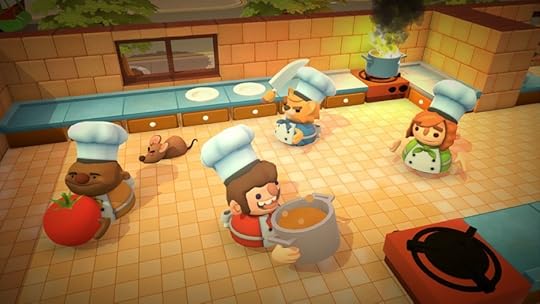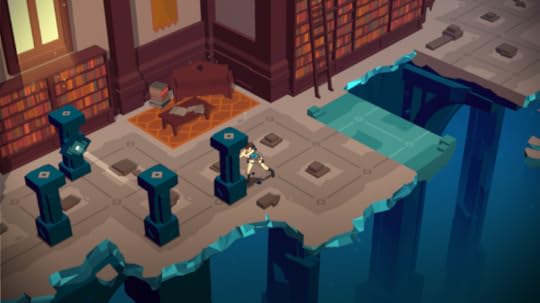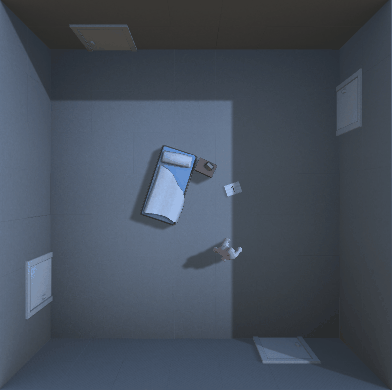Kill Screen Magazine's Blog, page 19
December 26, 2016
High Scores: The Best Videogames of 2016 – 20 to 17
Darkest Dungeon will punish you. The “dungeon,” a dusty and generic RPG fixture, is twisted into a locus of psychological torment and trauma. Relentlessly grim voiceover and inky Mike Mignola-esque art drive home the game’s hammer-blunt central message: violence takes its toll. There is no happy ending, no glory as you sentence yet another band of recruits to the serpentine catacombs coiling beneath your ancestral estate. They return—if they return at all—with their minds and bodies broken, their blood indelible and thick on your hands. Happy adventuring.
By Zach Budgor
19. Thumper
Watch this. Now imagine the music as a gigantic iron skull floating in a lysergic soup of bleeding neon, assaulting you with noise, forcing you to bend to its rhythmic will. That’s Thumper. Thumper is not a rhythm game, not in the way we expect them to provide a venue for the player to play a song and feel accomplished. Mastery is close to impossible in Thumper. It fights you at every turn, the screen clogged with noise, the spare brassy thud of the music elusive and unsatisfying. When you lock into a hard, violent motif, when you clear a section, there is no respite. The next assault is seconds away. It’s a never-ending anxiety attack.
By Zach Budgor
18. Overcooked
I don’t remember the last time a game tested relationships—be they romantic, platonic, or familial—like Overcooked. Overcooked doesn’t occupy the comfortable space of competitive play, like the Nidhoggs and Towerfalls of yesteryear. Oh no. Overcooked dares you to do something more: to work together. To bark commands at one another bitterly; to coordinate to ensure rats don’t steal any of those precious, already sliced ingredients. A round of Overcooked singlehandedly wields the potential to destroy relationships, or cement them forever. But in the end, it’s your choice. Now, pass me three onions stat for this goddamn soup, or you’re dead to me.
By Caty McCarthy
17. Triennale Game Collection
Few other games have experimented with duration, input, and form as confidently as the five entries in the Triennale Game Collection this year. In their short play times, each game manages to speak to our natural curiosity or the complexities of the human experience. You explore a maze of memories, find magic in mundane objects, and form a friendship over several sessions. It’s a convincing showcase of what videogames can be and what more of them should aim to achieve.
By Chris Priestman
The post High Scores: The Best Videogames of 2016 – 20 to 17 appeared first on Kill Screen.
December 22, 2016
Final Fantasy XV wants to be the next great road trip but can’t shut up
There are five central characters in Final Fantasy XV. The first four are young men with impeccable hairdos and absurd names: Noctis, Gladiolus, Ignis, and Prompto. The fifth is a sleek black convertible stately enough to be named the Regalia.
Like every other Final Fantasy game, XV is about a long, dangerous journey across a fantastic landscape. Unlike the rest of the series, though, it doesn’t hang its story on the stuffy conventions of a Lord of the Rings-style cross-country wilderness hike, but through a road trip. The car, in Final Fantasy XV, is a central character. The Regalia is obsessively, onanistically detailed, its sleek chassis lengthened with horizontal lines that imply speed and a bulky hood so low and wide that a head-on view resembles a sporty snowplow. As the game’s heroes grow in power so too does the Regalia. Eventually, the sucker can even transform and take flight.
the car represents personal freedom
Final Fantasy XV, created by Japanese studio Square Enix, couches its road trip in the Americana of truck stop diners and an expansive country of varied climates (desert, coastal beaches, forests). From the succession of cars that brought Jack Kerouac around the continent, to Tom Wolfe’s time on Ken Kesey’s psychedelic school bus and John Steinbeck’s “Rocinante”—the camper he lived out of while navigating the U.S.—the American road trip is defined by its vehicles. But these stories are almost never directly concerned with the car itself. In the American imagination, the car represents personal freedom.
Still from Thelma & Louise (1991)
In film, the vehicle carries obvious visual significance. Captain America’s star-spangled motorcycle in Easy Rider (1969) became iconic shorthand for American outsiders. In Thelma & Louise (1991), the titular duo escapes the confines of patriarchy by taking to the road in a brawny Ford Thunderbird, ultimately vaulting off the Grand Canyon—suicide as an act of rebellion.
Final Fantasy XV is the latest game to explore the thematic potential of the road trip, but it’s far from the first. ceMelusine, Lucas J.W. Johnson, Andrew Grant Wilson, and Claris Cyarron’s Glitchhikers (2014) takes place entirely behind a car’s steering wheel. The player drives down a highway late at night, listening to the radio and chatting with the strange hitchhikers who occasionally materialize in the passenger seat. Johnson calls road trips “the perfect recipe for those mental meanderings that take us places we might not go otherwise.”
This is evident in how Glitchhikers bends the meditative nature of nighttime driving to surreal effect. It’s an approach also notably taken by Cardboard Computer’s Kentucky Route Zero (2013-ongoing), which sketches a modernizing American South through a cast of characters piled into a run-down delivery truck as they navigate a network of highways stretching into a strange subterranean world.
Glitchhikers is a very different game to Kentucky Route Zero, but both capture something essential about road trips. Johnson finds the root of this in the fact that cars are a liminal space—”a place between.” Both games suspend you in that in-between place, free from the tethers of daily life, elongating moments of twilight strangeness that otherwise might slip by without notice. It seems like a small thing, but the act of changing lanes and pressing forward on the accelerator in Glitchhikers places the player within the scene in a way unique to games.
MinskWorks’ in-development Jalopy puts you in the driver’s seat of the Laika 601 Deluxe, a boxy, fictional Soviet sedan reminiscent of historic vehicles like the Trabant. The player, whose face is never seen from the game’s first-person perspective, is represented by interactions with the car, which has to be continually maintained, repaired, and upgraded—from manually popping the hood to fix or refit components to raising a jack to replace tires—on a long-haul drive, buying and selling goods in perestroika-era Eastern Europe.
here it fails to be truly meditative
Jalopy’s Laika isn’t just a car, but an opportunity for freedom of movement and economic opportunity previously limited for citizens of the USSR and its satellite states. These heady concepts are channeled through play: the player feels the distance travelled on highways because she isn’t just observing the trip, but driving it herself. Earning money becomes a hard-won personal accomplishment, felt through the game’s systems rather than simply shown in the way of film or literature.
Greg Pryjmachuk, MinskWorks’ founder/designer, calls the car “your lifeline. It carries your load, gets you where you want to go, keeps you shielded from the elements.” It’s a character that the player is likely to form an attachment to as their form of income, protection, and freedom.
Final Fantasy XV doesn’t make players maintain the Regalia other than fueling up, and its characters aren’t really equipped to provide the heady conversations of Glitchhikers’ nighttime drive either. Instead, it’s a more hollow symbol, one that evokes but doesn’t fulfill the promises of The Car. This is clear from the moment the player first takes the wheel.
Despite its sporty look and the implications tied up in being, well, a car, the Regalia isn’t responsive in a Need for Speed way. Instead it drives almost by default, even in “manual” mode, ostensibly putting an emphasis on idle reflection as you watch the passing landscape. But here it fails to be truly meditative. Every time the player finds herself relaxing, zoning out to the sound of the engine or sleepily listening to the radio, one of the characters pipes up with a bit of inane, throwaway dialogue or the game halts you on a night drive for a random battle.
Final Fantasy XV doesn’t let the player reflect on or appreciate the Regalia as more than a pleasant aesthetic point of reference. Driving doesn’t impart anything of substance because the game keeps interrupting itself; it’s a signifier, a trapping in the same way the game throws around rural American and opulent European stereotypes—to say nothing of real-world brands like Cup Noodles and Coleman.
Unlike other games that have explored driving, Final Fantasy XV doesn’t make it matter through play. It’s only in looking outside the game, tracing the lineage of the car, that we can fill in the gaps. Then the Regalia becomes something more than just a vehicle, its cultural significance turning it into the character the game wants it to be.
The post Final Fantasy XV wants to be the next great road trip but can’t shut up appeared first on Kill Screen.
New documentary focuses on the struggle of making independent games
Devolver Digital has published a new documentary on Steam called Surviving Indie. The idea of the documentary is to bring more attention to the struggle of being an independent game maker. In some ways, it feels like it might be a response to Indie Game: The Movie, which has been criticized by some since its release in 2012 for glorifying the vocation given that it mainly followed three successful game makers: Jonathan Blow, Edmund McMillen, and Phil Fish.
What Surviving Indie sets out to do is to get game makers “with varying outcomes of success and failure” to talk about their struggles and triumphs. The trailer and the descriptions around the documentary—which I haven’t watched yet—show an emphasis on what it calls “failing forward.” By that it’s meant that the people in the documentary have managed to continue making games but all acknowledge the challenges they faced—whether financial, emotional, or technical—that pushed them close to quitting.
“Surviving Indie tells the stories of those who have made it, those who have not, and those who are still trying,” we’re told. “It presents a realistic discussion about the oft-romanticised world of independent game development.” To this end, the documentary features interviews with known names like Rami Ismail (Ridiculous Fishing), Kellee Santiago (Journey), and Jay Tholen (Dropsy), who have all had at least some success in making videogames.
what it’s like going through that struggle in the moment
But there’s also Becca Bair Spurgin, who’s in the process of making her Kickstarter-funded tactical RPG called Arcadian Atlas, who is in a position to show what it’s like going through that struggle in the moment. Also included are Ryan Zehm of Nurface Games and Tyler Coleman of Retora Game Studios, not to mention the director of the documentary, Richard James Cook, who has made both movies and games in the past.
Without having watched the documentary I can only say that I hope it gives a better representation of the reality of making games by themselves or in small studios. I would have liked to see a bigger representation of people who have tried to make a living making games and failed than what seems to be on show here, but that is not quite the focus of this documentary. A documentary with that kind of focus is still to come, and I’m not sure it ever will given that it goes against the popular narrative of independent games, and will ultimately be quite depressing, so who would want to watch that?
You can find out more about Surviving Indie on its website. It’s available to purchase on Steam.
The post New documentary focuses on the struggle of making independent games appeared first on Kill Screen.
Videogames are finally experimenting with the time loop of Groundhog Day
Before I had even watched Groundhog Day (1993), my childhood was fringed with the fantasy of alternate experiences of time due to a British children’s TV series called Bernard’s Watch (1995-2005). Bernard, the lucky bugger, had a stopwatch that could freeze time. Each episode he’d perform this miraculous feat, usually to enact some good deed, or at least get himself out of trouble. Thank god it was good boy Bernard that had the watch and not someone more perverse, eh?
The image that sticks with me the most from that show is Bernard running across a grassy field as someone frozen in time flies a kite (also frozen in time). The teaser trailer for upcoming game Escape the Loop took me straight back to that image and those childhood fantasies. As you can watch below, the trailer shows a white picket fence neighborhood paused indefinitely, only the camera moving as it zooms around the tableau: at one point some dude is seen midway through being thrown off his bike—he shouldn’t be cycling on the pavement anyway.
But Escape the Loop‘s temporal puzzles don’t involve time being stopped as the trailer depicts. Its time-based fantasy is a little more harrowing, as anyone who has watched Groundhog Day (or that one Xena: Warrior Princess episode) will know. Yep, you’re stuck in a time loop and have to escape. But unlike Groundhog Day you don’t get a whole day before the loop is reset—you only get five minutes. Ideal for a short experimental videogame.
“Everything resets. You keep nothing”
When time does reset in Escape the Loop, nothing you did previously will be recorded, nor will it reappear during your next attempt at breaking the loop. “Everything resets. You keep nothing,” as the game’s description reads. “Except your memory of past loops.” The idea, then, is to explore how you can interact with those five minutes to cause different sequences of events. If you do nothing then the loop will be exactly the same, but the same sequences can also be repeated if you perform certain actions at certain times. From this you can build a working knowledge of the different possible outcomes of the loop to use to your advantage.
Escape the Loop isn’t the only game messing with time in this way. I’m not talking about Majora’s Mask (that was years ago) or this year’s SUPERHOT, which tied the progression of time to your movement, but am talking about The Sexy Brutale and the upcoming Twelve Minutes. Both of these are temporal puzzle games with a time loop that you’re tasked with escaping. Except in both of these there is a big consequence to your failure: in The Sexy Brutale you’re trying to stop a series of murders at a masquerade ball, while in Twelve Minutes you’re trying to avoid being arrested in your flat. Escape the Loop may well have a similar incident at the end of its five minutes but it’s not on show yet—though I do spy what appears to be a nuclear bunker in one screenshot.
No matter, as Escape the Loop will be coming to Steam Early Access shortly, with a view for the full version to be released by the end of 2017.
Find out more about Escape the Loop on its website.
The post Videogames are finally experimenting with the time loop of Groundhog Day appeared first on Kill Screen.
Here’s a tip: Break games to find new ones
Sign up to receive each week’s Playlist e-mail here!
Also check out our full, interactive Playlist section.
Broken Breakout? (Browser, Windows, Mac)
By Tim Garbos
One person’s trash is another person’s treasure. That’s how the old adage goes. But can it be applied to videogames? Tim Garbos seems to have set out on a solo mission to prove that it can with his Ludum Dare 37 entry Broken Breakout? The game follows the same rules as the Atari arcade classic but takes away some of the mechanics. For starters, the bat is immovable and the ball isn’t perpetually bouncing around. But what you can do in this version of the game is move the window the game sits in. Through this means you can use the game’s physics to nudge the ball up to hit the bricks. It’s a lesson in how breaking a game might lead to the invention of another one, or at least a new way of playing an old one.
Perfect for: Arcade addicts, oldies, game designers
Playtime: 10 minutes

The post Here’s a tip: Break games to find new ones appeared first on Kill Screen.
December 21, 2016
Nina Freeman’s game based on her mom’s childhood comes out in January
Nina Freeman has announced that her next game, called Kimmy, will be out on January 6th 2017. It will be part of the Humble Monthly Bundle and so the price of the subscription you’ll get Kimmy and some other games. That’s something to look forward to in the new year, then.
As Freeman revealed to us before, Kimmy is based on her mom’s experience growing up and babysitting around urban Massachusetts in the 1960s. Specifically, it’s based on her mom’s recount of a certain summer that involved playing lots of street games, as well as babysitting a kid with “kind of a weird family situation.” The game itself reflects all this as it has you playing a babysitter called Dana who is looking after the titular Kimmy, helping her make friends with the other kids in the neighborhood. “You collect trinkets to play street games, and learn more and more about Kimmy as summer passes by,” reads the description.
based on her mom’s experience growing up
While Kimmy is based on Freeman’s mom’s experiences, she did tell us that she has in some part drawn on her own life. “I’m mostly drawing on my own experience as I write the character dialogue,” Freeman told us. “The player spends a lot of time getting to know the other kids in the neighborhood, learning about their lives, and having these little conversations with them. Some of that draws on my personal experience, and conversations I remember having as a kid, and kids I remember meeting.”
Freeman is, of course, used to drawing from her own experiences for her games. It’s how she came up with the ideas for her previous games: the exploration of sex in how do you Do It?; the sexual assault of Freshman Year; and the online relationship of Cibele. Freeman has brought back previous collaborator Laura Knetzger for Kimmy, this time as both artist and co-writer.
“It’s especially exciting to have her as my co-writer, because her writing work in her comics is really great,” Freeman told us previously. “She also made this game I really like called Don’t Go In The Old Greene House, and the writing in that made me think she’d be a super good writer to collaborate with.”
To see how the collab worked out this time around you’ll have to wait until January 6th to get your hands on Kimmy.
Find out more about Kimmy on its website.
The post Nina Freeman’s game based on her mom’s childhood comes out in January appeared first on Kill Screen.
Antioch: Scarlet Bay’s multiplayer approach to storytelling seems fresh
Antioch: Scarlet Bay looks like it’s set to take storytelling in videogames in a worthwhile direction. Out on April 6th 2017 for iOS and Android, it’s an adventure game set in the titular dark metropolis where you play as a detective investigating a homicide. That’s not the cool bit. It’s the fact that this is an online multiplayer game that should make you sit up and pay attention (it can also be played solo).
Yes, there are two detectives working on this case, and you’ll have to cooperate with each other as you work through the game’s story. You’ll each set out into the neo-noir streets of Antioch to gather clues, find evidence, and speak to the colorful faces of the population who may or may not lead you closer to solving the case. The characters you meet will especially alter the path that you end up investigating as they each apparently have their own agendas, but it’s up to you whether or not to pursue them.
you don’t always need to agree with your partner
It seems that, in some cases, you’ll have to talk to your partner—who, don’t forget, is another human player—to decide how to handle a given situation. Together you’ll decide which direction the story takes. However, it’s also said that you don’t always need to agree with your partner, implying that you can go your separate ways with your investigations. But you’re still both on the same case, which might mean that your independent decisions have an effect on the line of investigation your partner has taken. Perhaps it’s best to work together, then?
That potential push and pull of the narrative between two players is what grabs me the most about Antioch. We’re so used to videogames being under our control, and for them to ask us to make decisions, either through our actions or direction A or B choices. But in Antioch there’s room for that control to be taken away from us, and not in favor of the game’s designers, but another human player who has their own interests and hunches they wish to follow.
The creators of Antioch an encouraging awareness of this potential that they have set up. “We love text adventure games, and we wanted to approach them differently,” reads the creators’ statement. “We really believe that multiplayer will breath new life to this genre, giving more depth to your choices, because you’re playing with another human being.”
The concept of the game isn’t the only reason to care about it either. You can add to that the talent making it. It’s the work of a new French studio called Midnight Mood Studio, who are produced by Mi Clos Studio while the story is written by FibreTigre—the same team that created the existential space exploration game Out There. That game still gives me chills when I think about it.
Unfortunately, the team behind Antioch isn’t currently releasing much more information about it right now. However, below there are some new, exclusive screens from the game for you to wrap your eyes around. Get in there and have a proper good look. Some of it looks more Blade Runner than Blade Runner 2049, don’cha think?
You can find out more about Antioch on its website.
The post Antioch: Scarlet Bay’s multiplayer approach to storytelling seems fresh appeared first on Kill Screen.
The independent studio behind some of Lara Croft GO’s best levels
Lara Croft GO came out for PlayStation 4 and PlayStation Vita on December 3rd this year and brought with it a time-exclusive set of levels. Called “Mirror of Spirits,” these levels take the grid-based puzzles of the game’s dioramas in a radically new direction than the main levels and the first expansion, “The Shard of Life.” Whereas before Lara was dodge-rolling through jungle and underground caverns, concerned with the paths of rolling boulders and pursuing lizards, in “Mirror of Spirits” she enters a new reality through the titular mirror, where a completely new set of rules change the makeup of the game.
The reason why these levels are so different than the others is easily explained: they weren’t created by the original team at Square Enix Montreal. They’re the work of another Montreal studio, KO_OP Mode, the makers of upcoming puzzle game GNOG, which will have you spinning monster heads to explore the tiny worlds inside them next year. It was Antoine Routon, the co-creator of Hitman GO and Lara Croft GO, that first saw GNOG (at PAX East, apparently) and reached out to Saleem Dabbous of KO_OP Mode to arrange a meeting.
KO_OP Mode started to explore as many wild ideas as they could
“We thought it was unusual, but decided to meet over a drink to see what they wanted,” Bronson Zgeb of KO_OP Mode, and the puzzle designer of “Mirror of Spirits” told me. “As it turns out, Antoine had seen our game GNOG and recognized that our approach to making this small handcrafted ’boutique’ game aligned with their own approach while making the GO games. At that point the more we talked, the more we realized the similarities between our two companies. To me it feels like one of the only difference[s] between our design philosophies is the scale at which we’re operating at. ”
Accepting the offer to create a level pack for Lara Croft GO, the team at KO_OP Mode started to explore as many wild ideas as they could come up with, being as it were that Square Enix Montreal had given them full creative freedom. “In the end I think our tight timeline had a bigger role than Square Enix Montreal did dictating what we could do,” Bronson said. There was, however, one request, and that was that the new levels somehow tied into the 20th anniversary of Tomb Raider.
“I think we all had fond memories of exploring the original Croft manor, so we used that as our jumping off point for the new content,” said Bronson. “Our new chapter starts with Lara placing a new artifact (the mirror of spirits) in her trophy room. Doing so causes a chain reaction in which the mirror shatters, which effectively shatters reality along with it. Lara’s spirit separates from her body and runs off. The story then revolves around Lara exploring the shattered version of the manor while trying to rejoin her body and her spirit.”
With that as a starting point, Bronson initially began to explore several ideas that he could design puzzles around, but quickly narrowed it down to just a few. His goal was to find puzzle mechanics that didn’t overlap with those in the other Lara Croft GO levels. The first he came up with is, and what features a lot in the first levels of “Mirror of Spirits,” are eyes that appear all over the walls of the manor.
“These act as triggers that go off as soon as anything living walks in front of them, but they can also be blocked by pillars and boulders. They’re essentially push plates that extend to every tile in front of them,” Bronson explained. “After that, I took those same eyes and attached them to pillars. With that, now you have a trigger that you can move around the level, which adds an interesting puzzle layer about positioning your triggers in addition to all the other puzzle solving elements.”
“if one of them dies, they both die”
These eyes make for a number of tricky puzzles that, admittedly, I struggled with. Being able to move the eyes around the levels makes for quite a lot of different possible formations. Trying to find the right one each time certainly tested my resolve. What I enjoyed more while working through “Mirror of Spirits” is the big idea that characterizes the latter parts of the level pack. “The big mechanic that ties into our narrative is the addition of Spirit Lara, who mirrors the player’s moves but on a separate puzzle,” Bronson said. “The way it works is both Laras have to be able to make a move for it to be valid, and if one of them dies, they both die. Later we mix this up even more by allowing both Laras to cross the mirror plane into each other’s world in order to solve puzzles.”
This is good shit. Despite the presence of a second Lara doubling your required perception in each level, these levels don’t feel quite as tough. That’s probably true on a fundamental level, but I’d wager that these puzzles felt more enjoyable to me as they changed the foundations of the game, serving up something genuinely new. You have to think in pairs, but also take this line of thinking further, realizing that not only can Lara cross over into the mirror realm, but so can the animals hunting her. The inclusion of Spirit Lara also feels like a callback to the doppelgänger of the original Tomb Raider, in which an Atlantean Lara (or “Bacon Lara“) did the mirror opposite of your every move inside one room.
These mirror realm levels are some of my favorite puzzles I’ve solved this year, helped along by the extraordinary sound design: shattered glass, warped screams, distant echoes. They feel truly out-of-this-world in their realization. KO_OP Mode attributes this achievement to the creative trust that existed in the partnership with Square Enix Montreal. “Because of the timeline we had to move fast and make design decisions quickly and if that trust didn’t exist, I’m not sure we would have been able to actually ship,” Dabbous said. “And that goes both ways—when we pitched an idea and they let us know why they thought it would or wouldn’t work, we had to trust in their experience too.”
After this positive experience, KO_OP Mode is definitely up for doing more collaborations in the future. But next up for the studio is getting GNOG out in 2017.
You can purchase Lara Croft GO for iOS, Android, Windows Phone, PC, PlayStation 4 and PlayStation Vita. However, only the PlayStation versions have the “Mirror of Spirits” levels until March.
The post The independent studio behind some of Lara Croft GO’s best levels appeared first on Kill Screen.
December 20, 2016
The salaryman’s tragic tale turned into an efficient videogame theater
Videogames about the drudgery of working in a dead-end job, pushing piles of paper off a desk, are as old as, well … almost as old as videogames. One of the first was probably Takeshi no Chōsenjō, the 1986 game directed by Takeshi Kitano (known for the game show Takeshi’s Castle as well as starring in and directing his own films), which began by having you roam a Japanese city working as a salaryman. You stuck to the dull daily routine of a salaryman until you quit the job and worked out what else you could do.
But Takeshi no Chōsenjō wasn’t meant as a game with artistic aspirations—it was the opposite. It was the product of a man who confesses to hating videogames and therefore wanted to make the worst one he could. Hence he made the game experience more like everyday work; as far away from the fantasy lands of other games as possible. A game that’s more widely recognized these days for its depiction of the daily life of an office worker is Molleindustria’s 2009 game Every day the same dream. In fact, it seems to have served as the blueprint for the many copycat titles that came after it.
The monochromatic repetition of Every day the same dream captures the soullessness associated with working in a cubicle. You get up, travel to work, and then sit down for hours at a time in front of a computer, typing out the days for a corporation. It’s a line of work without passion, that treats workers like robots, and that revolves entirely around work output. Salaryman blues are real and it’s the anguish that underlies the economic machines driving our societies.
Given the easy looping of the salaryman’s day and the obvious iconography it carries, Every day the same dream has served as a blueprint for many copycat titles that came after it. It’s now a ‘type’ of game; a staple of art games. It’s too easy and obvious these days to make a game that essentially has the message: life working in an office is pretty shit. But The Employee, a game made for Ludum Dare 37 by Paul Lawitzki, is more efficient than most, so much so that it’s worth studying.
the walls and doors never changed
Lawitzki’s trick is to use a single diorama to draw attention to the monotony of the salaryman. It operates with a theatrical quality: the salaryman wakes up on the floor, turns off his beeping alarm, and exits stage through one of the four doors (one on each wall). However, he then immediately emerges from the door on the wall opposite to the one he entered, and the set in the middle of the stage is flipped through the floor to turn it from a bedroom to an office or a lunch hall. Through these three scenes the entire story is told, the walls and doors never changed, so that it all takes place in the same grey room.
This stylistic and formal choice is born out of the theme of Ludum Dare 37—”One Room”—which encouraged participants to set their games in no more than a single enclosed space. What Lawitzki turned out was a game that uses this restriction to create a work about the inescapably bland architecture of the salaryman’s life. The established narrative is told once again but, as said above, with a new efficiency. Henry Ford would be happy with this production. As the tragic repetition of the salaryman requires, the loop of The Employee goes on forever, until you decide to quit, at which point he keels over and dies—of course, the only escape is death.
The only other formalistic flourish that The Employee boasts can be seen in the shot below. And as you can see it’s a little on the nose: a Windows warning box appears at each of the doorways with the words “No Living Space” and “D[e]spair.” You should get the idea. All work and no play makes Jack a dull boy and all that.
It’s a shame that these feelings are so blasé these days as it means they’re becoming more universal, more and more people stuck in jobs they hate, unable to escape either metaphorically or physically from their salaried prisons. It is perhaps this that is encouraging a number of people to make games that focus on nature, growing plants in domestic spaces especially; tributes to the small joys that can be found within the urban loop.
You can download The Employee on itch.io.
The post The salaryman’s tragic tale turned into an efficient videogame theater appeared first on Kill Screen.
Brendon Chung’s latest game makes a mockery of RPGs
I missed the latest game by Brendon Chung (creator of Thirty Flights of Loving, Quadrilateral Cowboy) when he released it last month, but it’s certainly worth highlighting. Called Acre 6, it’s a deconstruction of the classic RPG, full of jest, made for the Procedural Generation Jam.
It starts you out with a map marked only with icons for areas of forest and landmarks like temples, ruins, and villages. The only interaction available is to move the mouse to guide a circle, representing you as the player character, who journeys across this map leaving a dashed line behind them.
open-world games rarely leave players to explore a map alone
After a short distance, a text bubble should pop up at a point in your journey, informing you of some event that happened there. You might find an item, defeat an enemy, purchase or be rewarded something, perhaps complete a quest or level up. The names of these events and items are procedurally generated and represent the typically absurd use of adverbs and nouns of the RPG (and fantasy literature too). I first found a “Famous Brick,” later hypnotized a “Nutty-Tank Fox,” and then purchased a “Faucet of Wicked Lo.” Here, Chung makes an effective joke out of the scrambled language that procedural generation is so conducive to.
He goes further. As each of the events burst into view, you gain experience, represented by a bar that fills up at the bottom, while the top of the screen hosts a bar that depicts the progress of each act. In the top left corner you’re informed of the date and how many years your journey has taken. Chung writes in the readme file for Acre 6, that it’s inspired by one of his favorite games, Progress Quest. It’s a similar game that removes all the depicted action and larger systems of the RPG and leaves only progress bars in their wake.
Acre 6 essentially does the same as Progress Quest, but it also adds to that the map, which starts out as a site of exploration, but is overwhelmed by the pop-up events of the player’s journey. It brings to mind the way that open-world games rarely leave players to explore a map alone, instead dividing them into various landmarks that can be navigated to with waypoints. It’s become something of a running joke that every open-world Ubisoft game will decimate its map with an atlas of icons showing the locations of side quests, dialogue opportunities, and viewpoints. This is what Acre 6 satirizes with its own map of messy and overblown annotations.
You can download Acre 6 over on itch.io.
The post Brendon Chung’s latest game makes a mockery of RPGs appeared first on Kill Screen.
Kill Screen Magazine's Blog
- Kill Screen Magazine's profile
- 4 followers


























